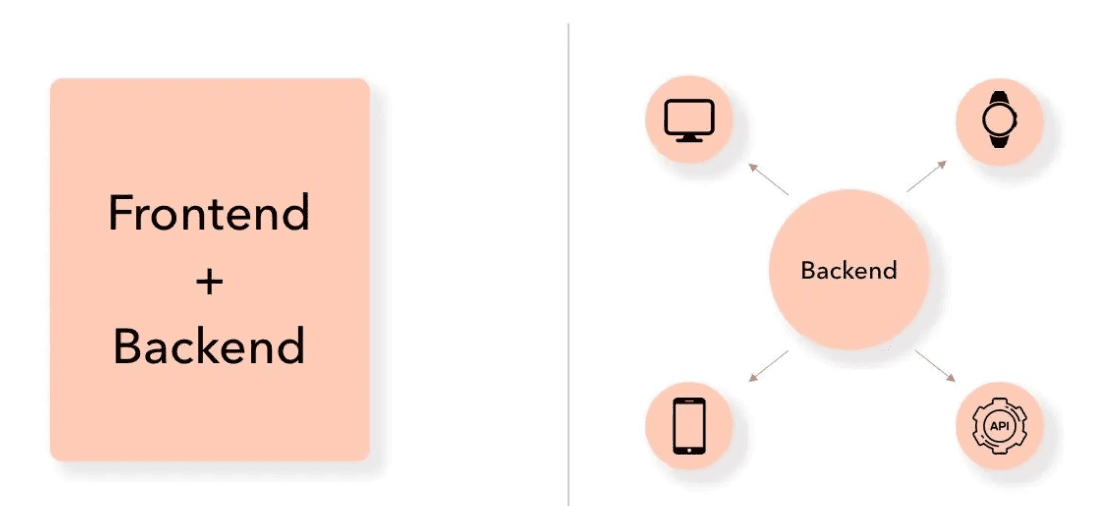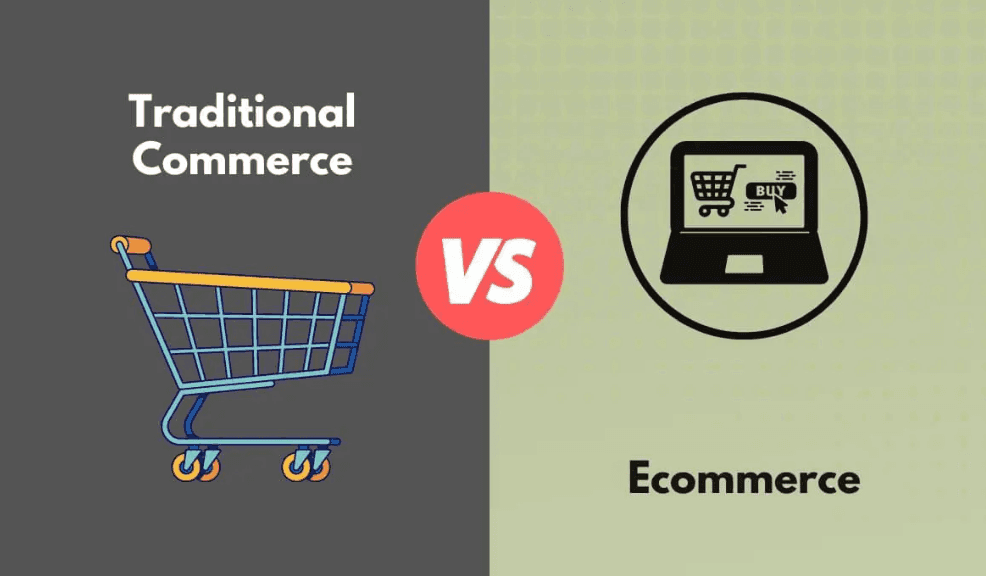Headless Commerce Vs Traditional Commerce Explained

Ecommerce consumers are constantly finding new, more comfortable ways of shopping online. These channels include smart watches, mobile apps, and more. And they want seamless, effortless, and preferably personalized shopping experiences across all touchpoints.
Going headless is one of the ways in which businesses are meeting their customers’ needs. According to a Salesforce State of Commerce report, 80% of businesses currently lacking headless architecture say they plan to implement it within two years.
But headless ecommerce platforms do not universally align with all business goals. Therefore, it is crucial to understand the difference between headless and traditional commerce to choose a more suitable solution.
In this discussion, we explore headless commerce vs traditional commerce and explain their key features, pros, and cons. We also clarify when to choose traditional or headless ecommerce solutions.
What Is Headless Commerce

Headless commerce is a more modern and flexible approach to building online stores where the front end and back end of an online store are decoupled.
Because the presentation layer (the front end) is separated from the business logic and data layer (the back end), headless commerce platforms use APIs (Application Programming Interfaces) to exchange data between the front end and back end.
This separation allows for greater flexibility in design, innovation, and user experience. Developers can choose the best technologies for each layer independently, and businesses can update one layer without affecting the other.
Headless commerce companies can deliver content and shopping experiences across different platforms and devices, meeting various user expectations more easily.
Key Characteristics of Headless Commerce
Decoupled architecture involving independent front end and back end that communicate through APIs
Flexible and scalable design, allowing for independent changes to each end
Faster innovation
Enhanced personalization with customized user experiences
Enhanced omnichannel support
Headless Commerce Pros and Cons
Here are some of the advantages and limitations of headless ecommerce.
Pros of Headless Commerce
It is flexible.
Its decoupled architecture allows for faster implementation of necessary changes.
Each component is independently scalable.
Headless commerce offers enhanced omnichannel support through APIs, allowing you to provide a consistent experience across various touchpoints.
The separation of layers enables enhanced personalization and customization.
It is technology agnostic, allowing you to choose the best technologies for each layer.
It offers better security by separating the front-end and back-end layers.
Cons of Headless Commerce
Headless commerce can be more complex to set up and maintain.
The initial costs of setting up a decoupled architecture might be higher.
Seamless integration via APIs can be challenging.
The learning curve might be steep for teams unfamiliar with the decoupled architecture.
What Is Traditional Commerce

Traditional commerce is a monolithic approach to building ecommerce platforms, with the front end and back end tightly integrated.
This approach is generally simpler and easier to use, making it ideal for smaller businesses whose requirements are straightforward.
Since the front end (the part of the website visible to users) and the back end (the database, server, and business logic) are tightly integrated, changes to one layer directly affect the other. Therefore, traditional commerce can be rigid and slower to innovate.
Security breaches to the front-end layer will likely affect the back end and vice versa. This makes traditional commerce platforms more vulnerable to cybercrime than their headless counterparts.
Key Characteristics of Traditional Commerce
Monolithic architecture involving integrated front-end and back-end
Limited flexibility and heavy developer dependency
System interdependencies
Minimal personalization and customization
Uniform presentation of content to all users
Traditional Commerce Pros and Cons
Here is a list of the advantages and disadvantages of traditional commerce.
Pros of Traditional Commerce
It is simple and more straightforward to troubleshoot and maintain.
Many developers and business owners are already familiar with it, so you can find resources and expertise for implementation more easily.
It has lower initial costs.
It can be more stable than headless ecommerce platforms.
Content management can be simpler.
Cons of Traditional Commerce
It has limited flexibility and is slower to innovate.
It has less personalization and customization to suit different customer segments.
Traditional ecommerce platforms can lock businesses into specific technology stacks.
It has limited scalability.
User experience across various devices tends to be inconsistent in traditional setups.
Traditional commerce platforms are more vulnerable to security breaches.
Headless Commerce Vs Traditional Commerce Head-to-Head
When it comes to building an ecommerce store, you can choose the traditional way or go headless. In this section, we will identify the key features of each approach relative to one another.
Architecture
As mentioned while introducing the two approaches to ecommerce platforms, traditional commerce is based on a monolithic architecture. This means the ecommerce platform has a firmly integrated back-end and front end.
If you make any changes to the back end of the system, it will be reflected on the front end. This means you must consider the impact of every change on both the back end and the front end, regardless of which layer you implement it on.
In comparison, a headless ecommerce solution comprises an independent front end and back end of a decoupled online shopping system.
A headless ecommerce system decouples the front end of the platform from the back end. The two presentation layers of the ecommerce store then communicate through application programming interfaces (APIs).
As a result, a headless ecommerce store allows for more flexibility in how the business creates the experiences for its various users. The business can target different users with different front ends communicating to the same back end through API calls.
Verdict: Headless commerce’s decoupled architecture may create a better customer experience.
Front End Development
While decoupling the front end from the back end in a headless commerce system offers flexibility and other benefits, developing it typically involves additional work.
One of the main appeals of headless commerce is that it provides greater customization. However, such customization requires more effort, technical expertise, and decision-making.
Designing and developing the headless front-end from scratch or integrating it with a compatible CMS, therefore, involves more work than a traditional solution.
Due to its integrated nature and pre-designed templates, traditional commerce offers a simpler front-end setup. For instance, if you choose Shopify or WooCommerce, you could easily build your shop’s front end by customizing a suitable theme and adding your content and products.
Customizing a theme is time-consuming indeed, but the work is nothing compared to building the entire front-end fabric from scratch.
When choosing a headless system, ensure your business has access to the required technical capabilities and willingness to invest in the customized front end.
Thankfully, the front end will pay you with unparalleled design flexibility and customization opportunities once in place.
Verdict: Traditional ecommerce front end is easier to set up.
Flexibility, Customization, and Scalability
Flexibility and limitless customization opportunities are among the greatest advantages of a headless system. The decoupled architecture allows businesses to tailor their front end according to their brand’s identity, providing unique experiences for different customer segments.
In contrast, traditional commerce offers quicker setup and deployment. But once in place, it can tie the business to the same tech stack or providers with limited ability to shift with changing customer preferences.
Traditional commerce typically involves working with a template connecting directly to the store’s back end. This invariably limits what you can do. And it can be difficult to scale and market your business down the line.
Verdict: Headless commerce is more flexible and scalable
Performance and Speed
Headless commerce’s decoupled nature allows for faster loading times and enhanced performance. This feature contributes to better user experience and satisfaction. It could also directly impact ecommerce sales since nearly 70% of consumers acknowledge that web page speeds impact their decision to buy from online retail stores.
In comparison, traditional commerce will likely struggle to achieve similar levels of speed and performance due to its integrated architecture.
Verdict: Headless ecommerce stores perform better
Requirement of Pre-Existing Knowledge
We already mentioned that setting up a traditional ecommerce storefront can be as straightforward as customizing a suitable theme from an ecommerce platform like Shopify. In most cases, businesses should be able to do this even with limited development knowledge.
However, setting up a headless commerce storefront typically requires creating it from scratch. Naturally, this requires advanced development knowledge. In this case, you must have the required knowledge to set up the storefront or go through a significant learning curve to acquire the technical knowledge.
Verdict: Traditional ecommerce is a relatively simpler option.
User Experience
Headless commerce excels in delivering a consistent and immersive user experience across different devices and touchpoints. A headless ecommerce software frees businesses from being tied to a specific front-end framework, allowing for managing and delivering content to multiple channels, including IoT devices, mobile, and web applications.
Traditional commerce, however, provides a reliable but less flexible user experience that might not be as seamless across various platforms.
Verdict: Headless commerce delivers a better user experience.
Development and Maintenance
Headless commerce demands a more complex development process, but it also enables easier updates and changes.
In contrast, traditional commerce requires less technical expertise for development and maintenance but might lead to challenges when implementing major changes.
Verdict: Headless commerce is more complex to develop but allows for easier changes.
Cost
Finally, you will likely pay less upfront fees to set up a traditional ecommerce store. The store may also deploy faster.
On the other hand, a headless commerce solution might have higher initial costs due to development complexity. However, you will likely enjoy long-term savings through enhanced performance and reduced maintenance efforts.
Verdict: Headless commerce is more cost-effective
Headless Commerce or Traditional Commerce: Which Is Better?

Headless and traditional ecommerce platforms have their fair share of strengths and limitations.
While top headless commerce platforms can be true game changers for many businesses, some businesses, especially smaller ones, may benefit better from a traditional setup. So, we’ll break down the instances where it will be most beneficial to use each.
When to Choose Headless Commerce
Headless commerce is an excellent choice for businesses with diverse sales channels, complex customization needs, and a focus on delivering cutting-edge user experiences.
Such businesses can benefit heavily from the endless customization that headless commerce offers. They can create targeted user experiences for different customer groups and demographics.
Also, consider a headless commerce solution if you sell niche products or a large volume of products that require scalability.
When to Choose Traditional Commerce
Traditional commerce suits smaller businesses with limited resources, straightforward requirements, and a need for quick setup and deployment.
It is also the ideal choice for any business focusing on just a few or a small variety of products.
Headless Commerce Vs Traditional Commerce: Final Take
In this headless ecommerce vs. traditional commerce discussion, the main takeaway is that headless commerce platforms have a decoupled front end and back end. Meanwhile, traditional commerce platforms have a monolithic architecture with integrated front end and back end.
This difference makes headless commerce solutions flexible and more scalable. They are also customizable and offer a better user experience due to personalization and consistency across different touchpoints.
In contrast, traditional monoliths tend to be easier to set up but are inflexible, with limited customization options. They may also cost less upfront but may cost more to maintain.
In our subsequent posts, we’ll go deeper into headless commerce and present the best to consider on the market.
Need help choosing between headless and monolithic ecommerce stores? The team of ecommerce experts at Endertech can help. Contact them today.
